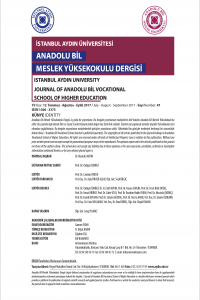Vanilya ve farklı alanlarda kullanımı
vanilya, vanilin, vanilyanın işlenmesi
Vanilla and its use in different fields
vanilla, vanillin, vanilya processing,
___
- Azeez, S., (2008). Vanilla. In: Parthasarathy, V.A., Chempakam, B., Zachariah, T.J .(Eds.), Chemistry of Spices. CABI Publishing, Wallingford, Kerala, India.
- Baqueiro-Peña, I., & Guerrero-Beltrán, J. Á. (2017). Vanilla (Vanilla planifolia Andr.), its residues and other industrial by-products for recovering high value flavor molecules: A review. Journal of Applied Research on Medicinal and Aromatic Plants, 6, 1-9.
- Bory, S., Grisoni, M., Duval, M. F., & Besse, P. (2008). Biodiversity and preservation of vanilla: present state of knowledge.
- Bythrow, J. D. (2005). Vanilla as a medicinal plant. In Seminars in İntegrative Medicine, 3(4), 129-131.
- Cai, Y., Gu, F., Hong, Y., Chen, Y., Xu, F., & An, K. (2019). Metabolite transformation and enzyme activities of hainan vanilla beans during curing to improve flavor formation. Molecules, 24(15), 2781.
- Chambers, A., Cibrián-Jaramillo, A., Karremans, A. P., Martinez, D. M., Hernandez-Hernandez, J., Brym, M. & Vanilla Genotyping Consortium. (2021). Genotyping-By-Sequencing diversity analysis of international Vanilla collections uncovers hidden diversity and enables plant improvement. Plant Science, 311, 111019.
- Dignum, M. J., Kerler, J., & Verpoorte, R. (2001). Vanilla production: technological, chemical, and biosynthetic aspects. Food Reviews International, 17(2), 119-120.
- Fladby, T., Bryhn, G., Halvorsen, O., Rosé, I., Wahlund, M., Wiig, P., & Wetterberg, L. (2004). Olfactory response in the temporal cortex of the elderly measured with near-infrared spectroscopy: a preliminary feasibility study. Journal of Cerebral Blood Flow & Metabolism, 24(6), 677-680.
- Garcia-Rivas, H. (2006). Cocina Prehispánica Mexicana, 9th ed. Editorial Panorama, Mexico.
- Havkin-Frenkel, D., French, J. C., Graft, N. M., Pak, F. E., Frenkel, C., & Joel, D. M. (2004). Interrelation of curing and botany in vanilla (Vanilla planifolia) bean. Acta Horticulturae, 93-102.
- Ho, K., Yazan, L. S., Ismail, N., & Ismail, M. (2009). Apoptosis and cell cycle arrest of human colorectal cancer cell line HT-29 induced by vanillin. Cancer Epidemiology, 33(2), 155-160.
- Kanbur, B. N. (2013). Preterm yenidoğanlarda uygulanan vanilya esansı ve anne sütü kokusunun apne sıklığı üzerine etkisi. (Yayınlanmamış yüksek lisans tezi). Haliç Üniversitesi/ Sağlık Bilimleri Enstitüsü, İstanbul.
- Kohan, J., 2007. Versatile vanilla. Food in Canada 67(8), 34–35.
- McCormick, D., & Carlise, J. (2013). U.S. Patent Application No. 13/695,485.
- Nascimento, T.A.d, Furtado, M.d.S.C., Pereira, W.C., Barberena, F.F.V.A., (2019). Vanilla bahiana Hoehne (Orchidaceae): studies on fruit development and new perspectives into crop improvement for the Vanilla planifolia group. Biota Neotropica. 19(3), e20180696.
- Odoux, E., & Brillouet, J. M. (2009). Anatomy, histochemistry and biochemistry of glucovanillin, oleoresin and mucilage accumulation sites in green mature vanilla pod (Vanilla planifolia; Orchidaceae): a comprehensive and critical reexamination. Fruits, 64(4), 221-241.
- Okigbo, R. N., Anuagasi, C. L., & Amadi, J. E. (2009). Advances in selected medicinal and aromatic plants indigenous to Africa. Journal of Medicinal Plants Research, 3(2), 86-95.
- Panisello, C., Peña, B., Gilabert Oriol, G., Constantí, M., Gumí, T., & Garcia-Valls, R. (2013). Polysulfone/vanillin microcapsules for antibacterial and aromatic finishing of fabrics. Industrial & Engineering Chemistry Research, 52(29), 9995-10003.
- Pena, B., Panisello, C., Aresté, G., Garcia-Valls, R., & Gumí, T. (2012). Preparation and characterization of polysulfone microcapsules for perfume release. Chemical Engineering Journal, 179, 394-403.
- Pena-Pereira, F., Lavilla, I., & Bendicho, C. (2009). Miniaturized preconcentration methods based on liquid–liquid extraction and their application in inorganic ultratrace analysis and speciation: A review. Spectrochimica Acta Part B: Atomic Spectroscopy, 64(1), 1-15.
- Ranadive, A. S., Havkin-Frenkel, D., & Belanger, F. C. (2011). ‘Handbook of Vanilla Science and Technology. eds. Havkin-Frenkel D and Belanger FC, Wiley-Blackwell, Chichester, 141-161.
- Sandheep, R. A., & Jisha, M. S. (2014). Screening and identification of potential Trichoderma sp. against soil borne pathogens of vanilla (Vanilla planifolia). Indian Journal of Agricultural Research, 48(6), 459-464.
- Savart, J.M., 2003. Vanille et parfums. Bulletin de la Socieıte´ ı´ de Pharmacie de Bordeaux, 142, 163–170.
- Shyamala, B. N., Naidu, M. M., Sulochanamma, G., & Srinivas, P. (2007). Studies on the antioxidant activities of natural vanilla extract and its constituent compounds through in vitro models. Journal of Agricultural and Food Chemistry, 55(19), 7738-7743.
- Sinha, A. K., Sharma, U. K., & Sharma, N. (2008). A comprehensive review on vanilla flavor: extraction, isolation and quantification of vanillin and others constituents. International Journal of Food Sciences and Nutrition, 59(4), 299-326.
- Umamaheswari, R., Mohanan, K. V. (2011). A study of the association of agronomic characters in Vanilla planifolia Andrews. International Journal of Plant Breeding and Genetics, 5(1), 53-58.
- Walton, N. J., Mayer, M. J., & Narbad, A. (2003). Vanillin. Phytochemistry, 63(5), 505-515.
- Yang, H., Barros-Rios, J., Kourteva, G., Rao, X., Chen, F., Shen, H., Dixon, R. A. (2017). A re-evaluation of the final step of vanillin biosynthesis in the orchid Vanilla planifolia. Phytochemistry, 139, 33–46.
- UNAM, 2016. Biblioteca digital de la medicina tradicional mexicana. http://www.medicinatradicionalmexicana.unam.mx/monografia. php?l=3&t=Vainilla&id=7505/ (Erişim tarihi 04.05.23)
- ISSN: 1306-3375
- Başlangıç: 2006
- Yayıncı: İstanbul Aydın Üniversitesi
Vanilya ve farklı alanlarda kullanımı
Ekin DİNÇEL KASAPOĞLU, Meryem BADAYMAN
Kentsel ısı adası, sıcaklık dalgaları ve halk sağlığı ilişkisi
Türk Mutfağında Zeytin Ve Zeytinyağının Kullanımı Ve Sağlık Faydası
Fonksiyonel bir içecek şalgam suyunun üretimi ve muhafazası
Burç ERSOY, Nuray CAN, Aysun SAĞLAM
Kara Yüzey Sıcaklığının ARIMA Yöntemiyle Modellenmesi ve Gelecek Tahmini: Antalya Uygulaması
Veri Madenciliği Analiz Yöntemleriyle İngilizce Hazırlık Sınıfı Başarı Analizi
Zeynep AYTOLU KÜLAHCİ, Zafer ASLAN
Fotovoltaik panel verimliliği ve maksimum güç noktası izleme
